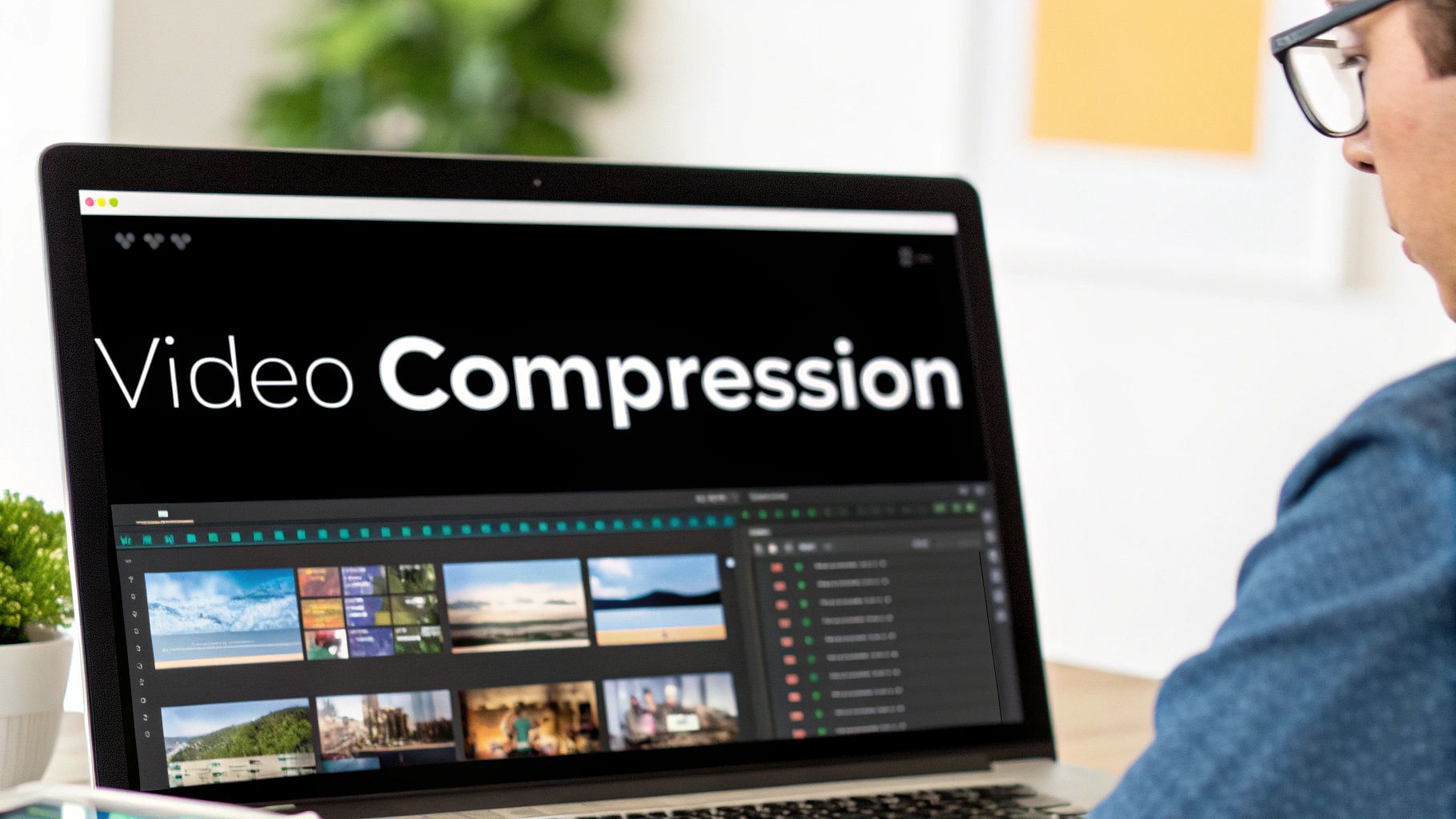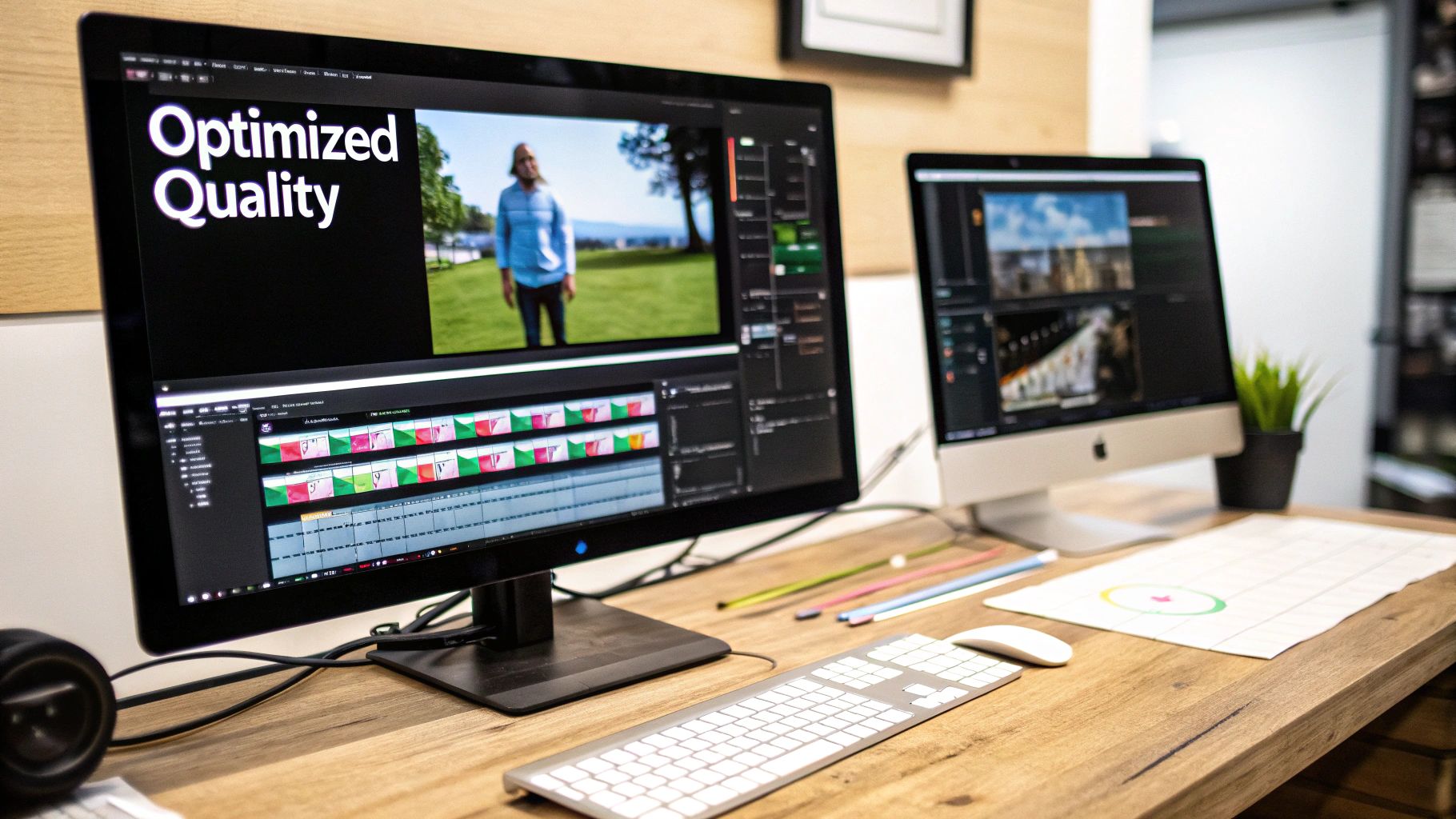Video compression for YouTube/TikTok: Optimize Your Videos
Demystifying Video Compression Fundamentals

Video compression is essential for sharing videos on platforms like YouTube and TikTok. It's all about balancing video quality with manageable file sizes. Think of it as packing for a trip – you want to bring everything you need without exceeding the baggage allowance. Compression achieves this by removing redundant data without significantly impacting the viewing experience.
Understanding the Basics of Compression
Codecs are the heart of video compression. These algorithms encode and decode video data. They analyze each frame, looking for similarities and changes. A static background, for example, doesn't need to be re-encoded in every frame. Codecs remove this redundancy, shrinking file sizes significantly. This efficient process ensures smooth streaming and quick uploads, especially vital for mobile-first platforms like TikTok.
Another fundamental concept is bitrate, measured in Mbps (megabits per second). Bitrate is the amount of data processed each second. Higher bitrates generally result in better quality, but also larger files. Imagine a water pipe: a higher bitrate is like a wider pipe, delivering more water (data) faster, but also requiring greater capacity. Balancing bitrate is the key to fast loading and uninterrupted playback, no matter the viewer's internet speed.
Video compression is essential for delivering high-quality content on platforms like YouTube and TikTok, especially given limitations in bandwidth and storage. Raw, uncompressed video can have incredibly high bitrates. A 1080p video at 30 fps, using YUV 4:2:0 color sampling, can have a raw bitrate of approximately 332 Mbps, or about 41.5 megabytes per second. Streaming this over a typical 100 Mbps home internet connection would be impossible. Video codecs like H.264 address this issue by exploiting frame-to-frame redundancy and motion prediction to dramatically reduce the bitrate. Learn more about this process on YouTube.
Frame Types and Their Role
Different frame types further optimize compression. I-frames are complete images, like individual photos. P-frames store only the changes from the previous frame, such as the movement of a hand. B-frames are even more efficient, referencing both past and future frames. The combined use of these frame types minimizes file size without major quality loss.
Choosing the Right Settings
Finding the right compression settings for your YouTube/TikTok videos is a balancing act. Fast-paced action might need a higher bitrate for clarity, while talking-head videos can use a lower bitrate. Experimentation is crucial. Find the sweet spot that balances visual quality with acceptable load times. Tools like Compresto can help, providing optimized presets and simple controls for managing compression settings.
YouTube Compression: Strategies That Actually Work

Getting your videos ready for YouTube takes more than just tweaking a few settings. It's about understanding how YouTube processes video and what your audience expects. The goal is to find the sweet spot: a video that looks great but also uploads and streams quickly. Imagine a super high-resolution video that looks amazing on a fancy monitor but buffers constantly for viewers with slower internet – not ideal.
Understanding YouTube's Transcoding Process
A key part of YouTube compression is grasping its transcoding process. YouTube re-encodes every upload into multiple versions at different resolutions and bitrates. This is called adaptive bitrate streaming. Think of it like a website having different sizes of the same image. Depending on the user's screen and internet speed, the website serves the best version. YouTube does the same, automatically adjusting the video quality for each viewer to prevent buffering.
This means creators need to upload the best possible source video. This is where recommended settings come in. YouTube suggests certain encoding settings to balance quality and file size. For 1080p HD, around 8 Mbps is recommended. For 4K, aim for 35-45 Mbps. The best video codec is generally H.264, with AAC audio at least 128 kbps. This ensures your videos play well on a range of devices and connections. For more details, check out YouTube's Encoding Recommendations.
Mastering Resolution, Bitrate, and Codec Selection
Picking the right resolution is fundamental for YouTube and TikTok compression. While 4K offers incredible detail, it's not always essential. Consider who you're making videos for and the content itself. A talking-head video might not need 4K, while a scenic travel vlog would benefit greatly. Our guide on optimizing videos for social media offers more platform-specific advice. Balancing resolution with bitrate and codec is a crucial skill for creators. You might also find value in resources like How to master video optimization.
The codec you choose plays a major role in final quality and file size. H.264 is a solid choice for balancing compression and compatibility. Newer codecs like H.265 (HEVC) and AV1 offer even better compression, sometimes with higher quality. But, not all devices support them. Consider your audience's devices when choosing your codec. This ensures your content reaches the widest audience with a great viewing experience.
Before we delve further into codec selection, let's take a look at a handy table summarizing YouTube’s recommended compression settings:
YouTube Recommended Compression Settings by Resolution
A comprehensive comparison of recommended bitrates, codecs, and settings for different video resolutions on YouTube. This table provides a quick reference guide for content creators.
| Resolution | Recommended Bitrate | Codec | Frame Rate | Audio Settings |
|---|---|---|---|---|
| 720p | 3-6 Mbps | H.264 | 24, 25, 30, 60 fps | AAC, 128 kbps |
| 1080p | 8 Mbps | H.264 | 24, 25, 30, 60 fps | AAC, 128 kbps |
| 1440p (2K) | 16 Mbps | H.264 | 24, 25, 30, 60 fps | AAC, 192 kbps |
| 2160p (4K) | 35-45 Mbps | H.264 | 24, 25, 30, 60 fps | AAC, 192 kbps |
This table highlights the importance of balancing resolution and bitrate for optimal YouTube performance. While higher resolutions demand greater bitrates, choosing the right settings ensures your videos look great and stream smoothly for everyone. Choosing the right settings is a crucial balance between quality and accessibility.
TikTok-Ready Video: Mobile-First Compression Tactics

While YouTube is designed for high-resolution viewing on larger screens, TikTok thrives on mobile. This core difference requires a separate approach to video compression. Creating videos that perform well on TikTok means understanding how people watch content on their phones.
Optimizing for Mobile Viewing
TikTok's focus on short, engaging videos demands fast loading and smooth playback, even with spotty internet connections. This means optimizing your compression for limited bandwidth and smaller screens. Think about the dimensions, aspect ratios, and compression settings that make TikTok videos look their best on smartphones.
- Aspect Ratio: The ideal aspect ratio for TikTok is 9:16 (vertical). This uses the full screen of most phones, maximizing the visual experience for viewers.
- Resolution: Aim for 1080p resolution (1080 x 1920 pixels) whenever you can. This balances quality and file size. Higher resolutions might seem better, but they can cause long upload times and buffering.
- Compression Settings: The key is finding the sweet spot between quality and file size. Try different bitrates to see what keeps your video looking good without sacrificing performance. Tools like Compresto can help you find the right balance.
TikTok's Compression Strategy: A Balancing Act
TikTok's compression strategy is a delicate balancing act. They aim to maintain quality for user engagement while keeping data usage low for a global audience, many of whom have limited internet access. TikTok’s approach is tailored to short, mobile-first videos, optimizing playback while minimizing data use.
TikTok videos typically range from 720p to 1080p resolution. Bitrates adjust dynamically based on network conditions. While the exact numbers are a secret, estimates suggest TikTok uses much lower bitrates than YouTube, often around 2-4 Mbps for 1080p videos. This prioritizes fast downloads and smooth playback on mobile networks worldwide. This lower bitrate is achieved using advanced codecs like H.264 and increasingly AV1 for newer devices.
Avoiding YouTube Compression Pitfalls on TikTok
YouTube’s recommended settings often result in large files that cause slow uploads and buffering on TikTok. What works for YouTube might not work for TikTok. The higher bitrates suited for YouTube’s larger screens and faster connections can hurt TikTok performance.
TikTok prioritizes visual clarity, even in short, fast-moving clips. They achieve this by compressing color and motion data. While this compression is sometimes noticeable, it allows for a balance between quality and bandwidth conservation. This balance is crucial to TikTok’s success.
Compression Tactics for High-Action Content
High-action TikTok videos present a unique challenge. Fast movement and quick cuts can look bad with aggressive compression. To keep the visual impact:
- Increase Keyframe Interval: More frequent full frames (keyframes) reduce the reliance on predictive frames, preserving detail in complex scenes.
- Consider Variable Bitrate (VBR): VBR lets the bitrate adjust to the complexity of each scene. More data goes to action-packed moments, and less to simpler scenes. This optimizes both quality and file size.
By tailoring your compression to TikTok's specific requirements, your videos will look good, load quickly, and reach a wider mobile audience. This is essential for success on a platform dominated by mobile viewing.
Choosing the Right Codec: Beyond the Basics

As we've discussed, compressing videos for YouTube/TikTok involves balancing quality and file size. Simply tweaking bitrate and resolution isn't enough. Your codec choice significantly impacts this balance. This section explores the strengths and weaknesses of common codecs and their effect on your final video. You might find this helpful: How to master H.264 and H.265.
Common Codecs and Their Applications
Several codecs are widely used for video compression. Each has advantages and drawbacks, making them suitable for specific applications.
-
H.264 (AVC): This codec boasts widespread compatibility, making it a dependable option. It provides good compression and quality, particularly for talking-head videos and content with minimal motion. However, H.264 may struggle with high-motion scenes, especially fast-paced gaming videos.
-
H.265 (HEVC): H.265 offers better compression than H.264, resulting in smaller files without sacrificing quality. This makes it an attractive choice for 4K video and high-action content. The downside is its limited device support, especially on older hardware.
-
VP9: Developed by Google, VP9 offers high-quality video compression. Its efficiency rivals H.265, and it’s royalty-free, making it popular on platforms like YouTube.
-
AV1: This open-source, royalty-free codec significantly improves compression efficiency. AV1 aims to deliver superior quality at lower bitrates. Like H.265, however, it lacks universal support, and encoding can be resource-intensive.
Codec Selection for YouTube/TikTok
The best codec for your video depends on your content, target audience, and platform requirements. H.264 is a safe bet for YouTube due to its broad compatibility. For high-resolution videos, H.265 or VP9 can significantly reduce file size without noticeable quality loss.
TikTok, a mobile-first platform, has different considerations. While H.264 is still common, TikTok is increasingly using AV1 for newer devices. This suggests AV1 may become TikTok's preferred codec, optimizing quality on smaller screens while minimizing data usage.
Making Strategic Codec Decisions
Experienced content creators carefully consider these factors when choosing a codec:
-
Content Complexity: Codecs like H.265 or AV1 excel at handling complex scenes in high-motion content such as gaming footage.
-
Target Audience: Think about your audience's devices. If they mainly use older devices, H.264 is a better choice than H.265 or AV1.
-
Platform Compatibility: Different platforms favor specific codecs. YouTube supports H.264, VP9, and AV1, while TikTok is moving towards AV1. A compatible codec ensures smooth playback.
To assist your decision-making, here’s a codec comparison:
Video Codec Comparison for Social Media Platforms
The following table compares popular video codecs based on key characteristics relevant for social media platforms like YouTube and TikTok.
| Codec | Compression Efficiency | Quality at Low Bitrates | Platform Support | Encoding Speed | Best Use Cases |
|---|---|---|---|---|---|
| H.264 | Good | Good | Excellent | Fast | General use, talking-head videos |
| H.265 | Excellent | Excellent | Limited (improving) | Slower | 4K video, high-action content |
| VP9 | Excellent | Very Good | Good | Moderate | Web video, YouTube |
| AV1 | Superior | Superior | Growing | Slow | Future-proofing, mobile devices |
By considering these factors and experimenting with different codecs, you can find the optimal balance for your YouTube/TikTok videos. Observing results on various devices is crucial for making informed decisions.
Compression Tools That Deliver Results
Picking the right video compression tools can significantly impact your YouTube and TikTok content. With a multitude of options available, finding tools that balance quality and efficiency is key. Through rigorous testing and conversations with content creators, we've compiled a list of top performers.
Software Solutions for Desktop
Desktop users have access to several powerful compression tools:
- HandBrake: This free, open-source software is an excellent choice for beginners. Its user-friendly interface and platform-specific presets, including options for YouTube and TikTok, make it easy to get started with video compression.
- Adobe Media Encoder: As part of the Adobe Creative Cloud suite, Media Encoder offers advanced features and seamless integration with Premiere Pro. This professional-grade tool, available with a subscription, provides granular control over compression settings for precise video optimization.
- DaVinci Resolve: This free software provides professional video editing, color grading, and powerful compression tools. While more complex, it's a comprehensive solution for experienced users looking to edit and compress videos within a single platform.
- FFMPEG: This command-line tool is favored by many professionals for its versatility. While offering extensive codecs and settings for precise compression control, FFMPEG requires technical expertise and isn't beginner-friendly.
- FlexClip: FlexClip empowers anyone to create stunning videos effortlessly with intuitive tools and rich creative resources.
For further tips on optimizing file size without sacrificing quality, check out this helpful resource: How to master file size reduction.
Mobile Compression Tools
Mobile apps provide convenient compression on the go:
-
Compresto (macOS): This app simplifies compressing video files for YouTube and TikTok while preserving video quality.
-
InShot: This popular mobile app is designed for editing and compressing short-form videos, particularly for platforms like TikTok. Its intuitive interface makes optimizing videos for mobile quick and easy.
Ready-to-Use Presets and Workflows
Many compression tools offer presets optimized for YouTube and TikTok. These presets provide a solid starting point, simplifying the compression process. Experimentation and fine-tuning are still important to achieve the best results for your unique content.
For example, a 1080p YouTube video might use the H.264 codec with a bitrate of 8 Mbps. TikTok videos, viewed primarily on mobile devices, often benefit from a lower bitrate, around 2-4 Mbps.
Key Takeaways for Choosing Your Tool
The best compression tool depends on individual needs and technical skills. Consider the following:
-
Skill Level: Beginners may find HandBrake's simplicity ideal. Advanced users can explore more complex options like FFMPEG or DaVinci Resolve.
-
Budget: Free tools like HandBrake and DaVinci Resolve offer excellent functionality. Professional software often requires a subscription.
-
Platform: Certain tools are better suited for particular platforms. Ensure your chosen tool supports optimization for your target platforms.
-
Features: Consider features like batch processing, customizable presets, and mobile compatibility.
By understanding these tools and using effective compression strategies, your videos can reach a wider audience on YouTube and TikTok while maintaining optimal visual quality.
Advanced Compression Techniques Worth Mastering
Beyond basic video compression for YouTube or TikTok, advanced techniques can significantly improve your video quality. These techniques let you go beyond generic presets and make informed compression decisions based on your specific content. This data-driven approach is the secret to success for many content creators.
Two-Pass Encoding: A Deep Dive
Two-pass encoding, though slower, significantly improves quality, especially for complex videos. Imagine scouting a location before filming. The first pass analyzes your video, identifying complex areas. The second pass then intelligently distributes the bitrate, leading to better compression and visuals. This method shines with high-motion or detailed videos, ensuring smooth action and crisp images.
Variable Bitrate Optimization
Variable bitrate (VBR) encoding dynamically adjusts the bitrate according to each scene's complexity. Think of it like a targeted watering system. A simple talking-head scene needs less data than a fast-paced action scene. VBR allocates bits accordingly, optimizing both quality and file size. This efficient use of your bitrate maximizes quality where it matters most.
Strategic Keyframe Placement
Keyframes, or I-frames, are complete frames that serve as reference points for other frames. Think of them as foundations in a building. While regular intervals often work, strategic placement boosts quality in videos with sudden scene changes or rapid movement. Keyframes at these crucial points minimize distortions and blurring. This targeted method enhances the viewer's experience, particularly in action scenes.
Content-Specific Compression
The best compression strategy depends on your content. A fast-paced gaming video differs from a talking-head vlog. Content analysis is crucial. Consider these factors:
- Motion: High-motion videos need higher bitrates and strategic keyframe placement.
- Detail: Highly detailed videos benefit from codecs like H.265 or AV1 that preserve detail.
- Color: Videos with rich colors require sufficient bitrate to prevent color banding.
Professional Workflows for Data-Driven Decisions
Professional content teams use data to guide their compression choices. They test and analyze rather than relying on presets. Comparing results across settings and devices helps them find the sweet spot between quality and file size for their specific content and audience.
This detailed approach distinguishes professional video from amateur work. By adopting similar testing and optimization, anyone can dramatically improve their videos. This includes monitoring viewer feedback and adjusting compression strategies as needed.
Ready to simplify your workflow and get professional results? Download Compresto for macOS today and start creating stunning videos with ease.